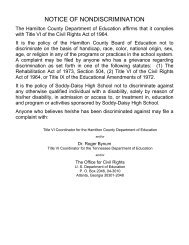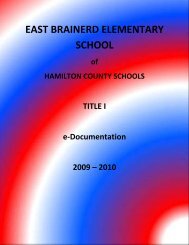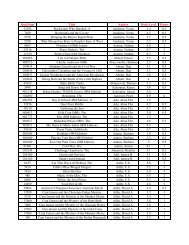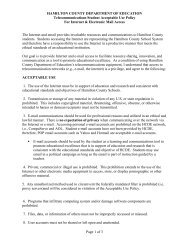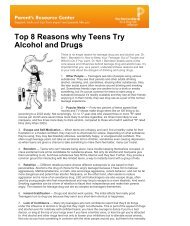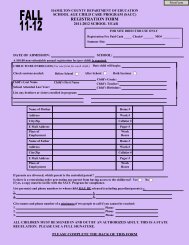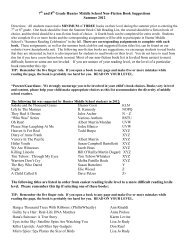RESOURCE PACKET Assessment of Language Impairment
RESOURCE PACKET Assessment of Language Impairment
RESOURCE PACKET Assessment of Language Impairment
You also want an ePaper? Increase the reach of your titles
YUMPU automatically turns print PDFs into web optimized ePapers that Google loves.
DETERMINING THE APPROPRIATE DISABILITY<br />
A Speech or <strong>Language</strong> <strong>Impairment</strong> should not be considered a secondary disability unless it is<br />
clearly apart from the primary disability. This is particularly applicable in the cases <strong>of</strong> Autism,<br />
Developmental Delay, Mental Retardation/Functional Delay, Multiple Disabilities, and Emotional<br />
Disturbance. Decisions about eligibility will be facilitated through collaboration among School<br />
Psychologists, the SLT, parents and school personnel in planning and implementing appropriate<br />
communication and cognitive assessments and interpreting their results.<br />
USING THE LANGUAGE SEVERITY RATING SCALE<br />
The <strong>Language</strong> Severity Rating Scale is a tool used after a complete assessment <strong>of</strong> the<br />
student’s communication abilities and after the SLT has interpreted assessment results. This<br />
scale is designed to document the presence <strong>of</strong> assessment findings according to the intensity <strong>of</strong><br />
those findings and to facilitate a determination, based on assessment results, if the student has<br />
a language impairment according to the definition in the Tennessee Rules and Regulations.<br />
The severity rating scale is not a diagnostic instrument and should not be used in the absence<br />
<strong>of</strong> assessment data. In order to be identified as a student with a language impairment, the<br />
language difficulties must be determined to have an adverse affect on educational performance.<br />
The rating scale serves three purposes:<br />
1. to document the absence or presence <strong>of</strong> a language deviation and to what degree (Mild,<br />
Moderate or Severe),<br />
2. to indicate the absence or presence <strong>of</strong> adverse effect on educational performance, and<br />
3. to determine whether or not the student meets eligibility standards for a language<br />
impairment.<br />
Educational performance refers to the student’s ability to participate in the educational process<br />
and must include consideration <strong>of</strong> the student’s social, emotional, academic, and vocational<br />
performance. The presence <strong>of</strong> any deviation in language does not automatically indicate an<br />
adverse effect on the student’s ability to function within the educational setting. The deviation<br />
must be shown to interfere with the student’s ability to perform in the educational setting before<br />
a disability is determined. The effect on educational performance is, therefore, best determined<br />
through classroom observations, consultation with classroom teachers and other special<br />
educators and interviews with parents and the student. Teacher checklists are useful for<br />
determining specifically how language problems affect educational performance.<br />
ED –4072 / Rev. 07.09<br />
Department <strong>of</strong> Education<br />
<strong>Language</strong> <strong>Impairment</strong> Resource Packet




